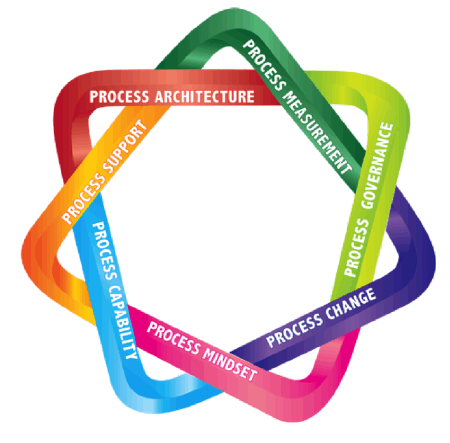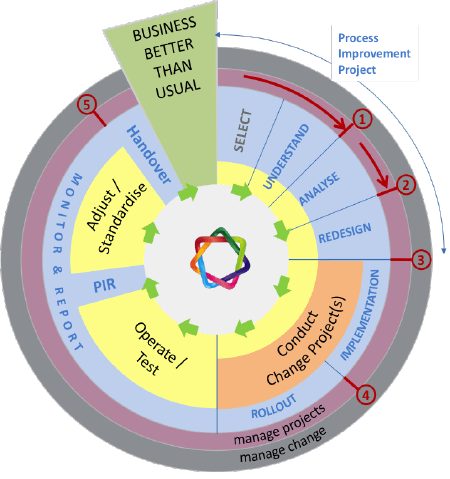Putting Process at the Centre of Business Management (Part 2)
Enabling the increasingly impossible demand to do even more with even less
by Roger Tregear
The first part of this article described the theory and practice of process-based management, an approach more commonly known as Business Process Management (BPM). It then introduced seven elements that come together to support process-based management and discussed the first three enablers: Process Architecture, Process Measurement, and Process Governance. These provide the 'physical infrastructure' on which the rest is built. The remaining four enablers are: Process Change, Process Mindset, Process Capability, and Process Support.

Figure 1. Seven Enablers of Process-Based Management.
Process Change
Process improvement is at the heart of all process-based management activities. The main reason for taking a process view of an organisation is to improve business processes. In discovering, modelling, and monitoring business processes, the main objective is to close performance gaps where cost-benefits can be proven. Process change is what makes doing 'more with less' possible.
Recruitment was proving to be very difficult for an organisation whose development plans were dependent on attracting new staff of considerable experience and expertise. However, often when an offer of employment was made it was found that the target of the offer had already taken another position. Over the previous 12 months this had happened in 73% of cases. This circumstance was jeopardising the achievement of an important strategic objective.
Documenting the 'Recruit Staff' process and obtaining detailed performance data showed that it was taking, on average, 12 weeks from receipt of an application to the offer of a position. No wonder the good candidates had taken other offers! The process was analysed in detail, with a particular focus on eliminating wasted time. As a result, the average cycle time of Recruit Staff was reduced from 12 weeks to three weeks.
None of the process changes required any IT development or modification but rather changes in the flow of paperwork, greater awareness of the impact of delays, removal of unnecessary steps, streamlining of approval stages, better assessment guidelines, and enhanced communication with the applicant. In the six months following the changes, 85% of all job offers were accepted by the first choice candidate. A welcomed, if unexpected, additional consequence of the changes was that labour costs related to the recruitment process were reduced by 22%.
Process improvement should be part of everybody's job. This work cannot be assigned to a small central group since that model will eventually mean that process improvement is delayed. A well-defined methodology that can be used by all staff is required to give effect to continuous improvement. Figure 2 exemplifies one such methodology.

Figure 2. The Process of Process Improvement (Leonardo Consulting).
Process Mindset
High levels of BPM maturity can only be achieved and maintained if a process-aware culture is in play. Making the idea of BPM resonate within an organisation requires deep engagement with the key challenges of contemporary management. If you don't 'think process', you won't 'do process'.
The achievement of effective, sustained process-based management is 90% mindset and 10% toolset. Too often we are focused on the 10%, at the expense of the 90%. The tools and techniques are critically important but they are not the main game. Having the right IT (and other) tools is a necessary, but nowhere near sufficient, condition for success.
It might be argued that the mindset/toolset emphasis is 80/20 (or perhaps even 70/30), rather than 90/10, but it's certainly not the reverse of any of those. Tools and techniques alone won't create a viral spread of the idea of BPM. Hearts and minds are also needed.
In a truly process-centric organisation (i.e., an organisation with a high level of BPM Maturity) every employee is conscious of their role in the execution of a range of processes. They are able to think beyond the activities described in their own job description to see their role in the bigger picture of creating, accumulating, and delivering value to customers and other stakeholders. The CEO of a large hospital recently surprised staff from the Finance, Operations and IT Departments by telling them that they were also 'caregivers'. He challenged them in this way: "If you are working in this hospital and not contributing directly or indirectly to the delivery of care to patients, then what are you doing?"
A process-aware organisational culture will have the following characteristics. It will be:
- measurement-friendly,
- community-focused,
- quality-motivated,
- change-welcoming,
- challenge-addicted,
- action-oriented.
All six of these attributes are important, but the most important is to be open to performance measurement. One of the most significant roadblocks to robust and sustainable process improvement and management is the absence of a measurement-friendly culture. In an organisation where measurement is a precursor to the allocation of blame, the instinct is to measure as little as possible and to conceal the measures that are unavoidable. Where performance measures are collected to facilitate disparagement, we cannot expect enthusiasm for testing and reporting performance.
A measurement-friendly organisation culture is a prerequisite for the success of process-based management.
During one process-improvement project, a strange conversation with a senior manager occurred. The project team was investigating a process with a customer satisfaction problem and had developed three change ideas that would significantly increase customer satisfaction at quite low cost. Quite rightly, the team was pleased with its work. However, the senior manager pushed back and found reasons why the changes should not be made. This went on for several days, with the team dispatching each new objection as it came up. Finally, the manager took the project leader aside and explained that his real concern was that if customer satisfaction increased from 83% to 95%, he would get sacked. He was prepared to accept a new target of 85% and that, over time (perhaps a year or two), it might be "safe" to achieve the 95% mark. He was serious. This was a culture of continuous dissembling, not continuous improvement. The culture was anything but measurement-friendly, and BPM development was inevitably handicapped.
Process Capability
As will be reinforced in discussion of the next enabler (Process Support), it is not viable to rely on a single central group to do all the process improvement and management work. This model simply does not scale. It is inherently self-limiting in the amount of successful process improvement that can be realised.
If process analysis and improvement is to be part of every employee's role, they need to be given the opportunity to develop the capabilities to be able to accomplish such tasks successfully. The too-common approach of exhorting staff to engage in continuous improvement without giving them the necessary tools and ability to use them is never going to be successful.
What capabilities are required? These are the main elements that staff must understand:
- General principles of BPM,
- Process improvement and management methodologies,
- Improvement idea generation techniques,
- Logistics and purpose of process performance measurement,
- Process governance arrangements and accountabilities,
- Modelling tools and conventions,
- Other related systems.
This doesn't mean that hundreds, or thousands, of staff need to attend extensive training courses. For many people these capabilities can be developed to an adequate level via short briefing sessions, published information, and participation in process improvement projects.
A BPM development plan is required to outline how the required capabilities will be formed for the various employee groupings.
Process Support
There is a requirement for a centralised support facility. However, it is not the job of any central group to do all of the process work in an organisation. Effective process improvement and management is based on distributed responsibilities and activity. If a central group does all of the process analysis, improvement, and management work then, when they are successful, they will not be able to respond quickly to an increasing level of requests for assistance. The central BPM group then becomes the reason that some process improvement work is not being done.
Supporting all of the stakeholders in process management and improvement, ensuring compliance with operational standards, and maintaining the central artefacts (such as the process architecture) is the proper role of a central Office of BPM (aka BPM Centre of Expertise, or Centre of Excellence). The main role of such a group is to raise the BPM capabilities of the rest of the organisation.
Many organisations have a long-term goal to create a central business unit tasked to manage, support, and nurture BPM throughout the organisation. Most organisations see this as an aspirational goal, only achievable once a certain level of BPM maturity has been realised. An alternative view is that the Office of BPM is a catalyst allowing faster and more certain realisation of the significant benefits to be gained from a process support facility.
For many organisations, a gap persists between their aspirations for process-based management and the reality of what is achieved. Such organisations strive to get traction with the ideas of BPM, but progress is slow. Creating an Office of BPM can galvanise interest and action, and provide a mechanism for effective control and support of the many process initiatives.
In Time
How long does it take to shape all seven enablers into a working BPM system?
Assuming there are the required resources and commitment, there are four answers to this question: three weeks, three months, three years, and forever.
- Within the first three weeks, initial training and customisation of the basic methodologies is completed. This is a time of preparation, both for future project activities and to establish an embryonic, but well informed, process mindset.
- Three months should be enough time to get most of the enabler infrastructure in place and to start delivering, or at least clearly identifying, performance improvements. A process architecture, with related methods and governance, should be available and in use. An Office of BPM (or some other form of central support and compliance management) should be operational. At least one process improvement project should be complete and offering credible performance improvements. That's a lot to achieve in three months, but the danger in taking longer to deliver tangible developments and practical benefits is that the organisation will lose interest and commitment will wane.
- Creating a new culture that is process-aware takes much longer. That's the three year milestone. At that point, process awareness should be embedded into day-to-day operations and decision making. This might seem like a long time, but genuine culture change does not happen quickly. The three-year anniversary should see a well-developed process architecture, with organisational performance being managed based on process outcomes, all staff regularly and competently in process improvement activities, and well-designed support available to all.
- In addition to the above 'rule of threes' it is useful to note that many aspects of process-based management are never complete — that's the 'continuous' bit of continuous improvement. The process architecture is never complete; there will always be changes to make to process measures, and there will always be processes to improve. The work goes on; BPM is a management philosophy, not a project.
In Summary …
To thrive, perhaps even to survive, in times when 'doing more with less' gets harder and harder, we must find another way to think about and deliver value — another way to get the right things done efficiently.
Traditionally, organisations are designed, funded, and managed in a functional sense, and the key artefact is the organisation chart. The inevitable focus is consequently on managing the entities represented by the boxes on that chart, but none of those can, by themselves, deliver value to external stakeholders.
We create, accumulate, and deliver value to customers and other stakeholders by working across the organisation chart. Value is created and delivered by collaboration between the functional entities, i.e., the boxes on the chart. In their important 1995 book[1] Geary Rummler and Alan Brache described this evocatively as managing the white space on the organisation chart.
We need both the functional view and the process view, but we miss the second view because the money and reporting structure are in the first. Senior executives need to take a step back from the day-to-day functional issues and reimagine their organisations as value creation and delivery flows.
This article has discussed seven enablers of process-based management — seven elements that will put management focus where it should be, on cross-functional value creation, accumulation, and delivery. If you accept the premise that no unit identified on an organisation chart can, by itself, deliver value to an external customer or other stakeholder (and how could you not do so?) then you accept the main concept of process-based management.
The inevitable consequence of this is acceptance of the certainty that processes must be identified, analysed, improved, and managed. Since the organisation chart is silent on the management of cross-functional processes, a separate, targeted, and comprehensive intervention is required to enable process-based management and to realise the benefits that come from it.
At a time when the requirement to 'do more with less' seems both inevitable and impossible, process-based management delivers a practical, proven approach.
References[1] Geary A. Rummler and A. P. Brache, Improving Performance: How to Manage the White Space on the Organization Chart, Jossey-Bass, San Francisco (1995). ![]()
# # #
About our Contributor:
Online Interactive Training Series
In response to a great many requests, Business Rule Solutions now offers at-a-distance learning options. No travel, no backlogs, no hassles. Same great instructors, but with schedules, content and pricing designed to meet the special needs of busy professionals.











How to Define Business Terms in Plain English: A Primer
How to Use DecisionSpeak™ and Question Charts (Q-Charts™)
Decision Tables - A Primer: How to Use TableSpeak™
Tabulation of Lists in RuleSpeak®: A Primer - Using "The Following" Clause
Business Agility Manifesto
Business Rules Manifesto
Business Motivation Model
Decision Vocabulary
[Download]
[Download]
Semantics of Business Vocabulary and Business Rules